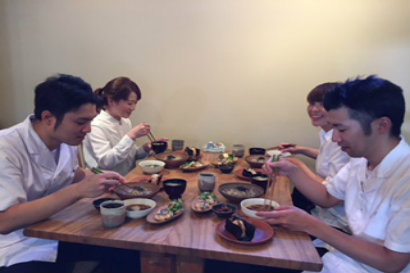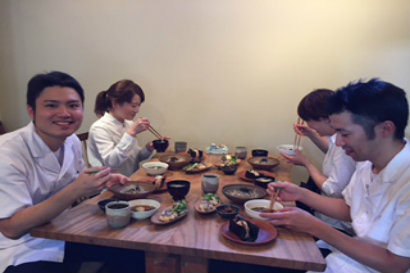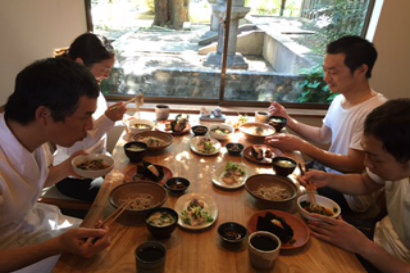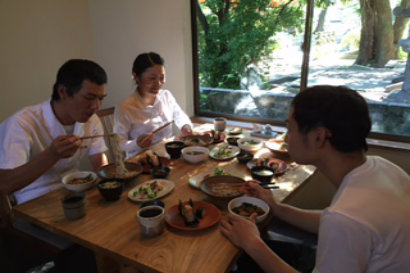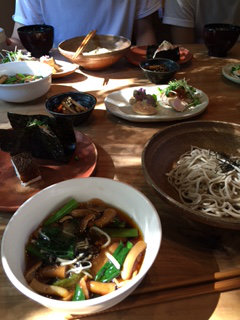Ichijyusansai / Nijyuyon sekki
Shubun no zen September 23rd

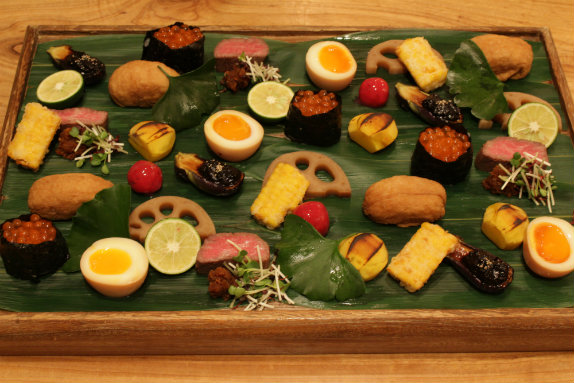
Ishijyusansai and 24 Solar Terms…
Shubun・・・This is when the length of the day and night are almost equal. It’s the time of year when you begin to feel the seasons changing; as they say, the hot and the cold only last ‘till “Ohigan” or equinoctial week.
Equinoctial week is coming. And because the Harvest Moon (Sept. 27th) is also near, we will be preparing a large platter you might enjoy when you get together with friends and family. While each recipe is a simple one, the platter can become quite fun and beautiful depending on how you arrange the food. We hope you enjoy preparing the food as much as you will enjoy the festivities.
All recipes make servings for four.
Menu List
-
Ikura Sushi
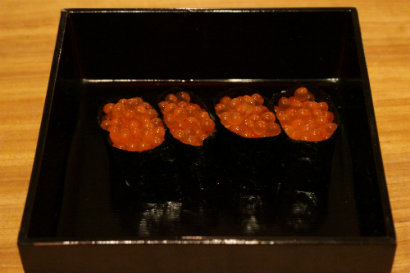 Ikura (Salmon roe caviar) marinated in soy sauce One egg sac
Ikura (Salmon roe caviar) marinated in soy sauce One egg sac
Sushi rice Enough for 4 pieces (please see Shiratsugu Basics)
Nori Seaweed Enough for 4 pieces(How to make Ikura marinated in soy sauce)
Sujiko (salmon egg sac) One egg sac
(A)
boil these 3 ingredients and cool
Water 250cc
Sake 250cc
Regular Soy Sauce 50cc
1. Prepare warm salt water at about 50℃, and gently unravel and remove the eggs from the sac.
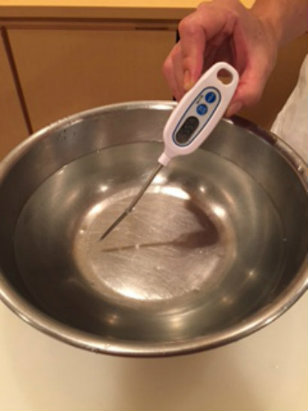
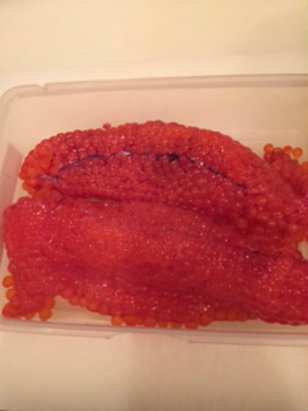
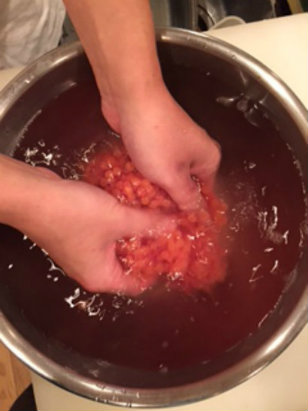
2. Strain the eggs, salt and continue to strain for 15 minutes.
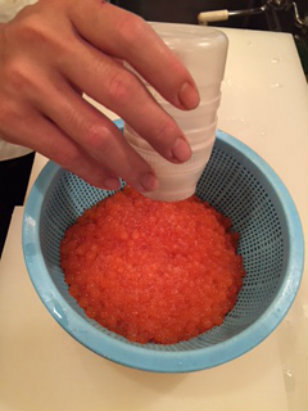
Ikura after 15 minutes
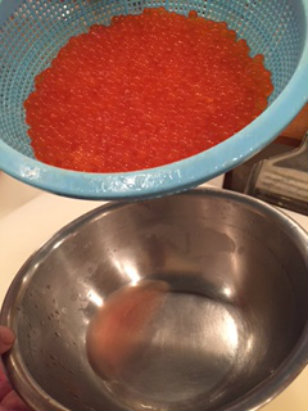
3. Put strained ikura into bowl and add (A), marinate for 3 hours to complete.
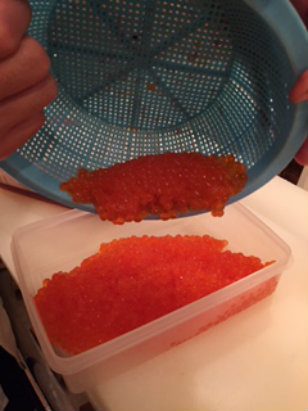
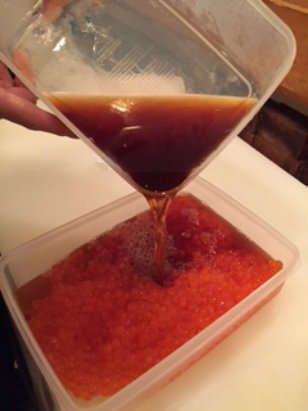
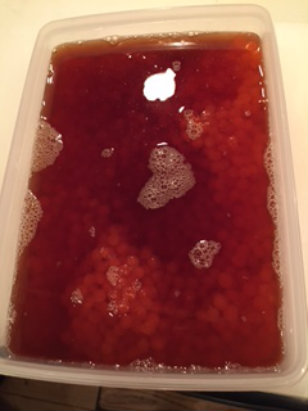
Advice
When you wash the Sujiko it is important to use salt water of the right temperature. If the temperature is too low it will be difficult to remove the ikura from the egg sac, and if it is too high, it will cook the eggs. (Using salt water at about 45℃ will make the ikura a little white but not to worry! If you add salt and strain the eggs well, they will turn into a brilliant orange color) -
Grilled Beef
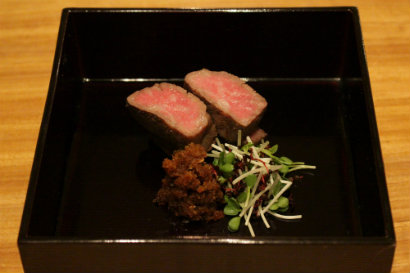 Ichibo (Aitch bone beef) 100g
Ichibo (Aitch bone beef) 100g
Kaiware (white radish sprouts) Desired amount1. Salt and pepper the Ichibo beef and grill 2. Cut beef into bite sized pieces, garnish with kaiware. Serve.
(How to grill Ichibo)
1. Take ichibo out of fridge and bring it to room temperature, then salt and pepper the beef
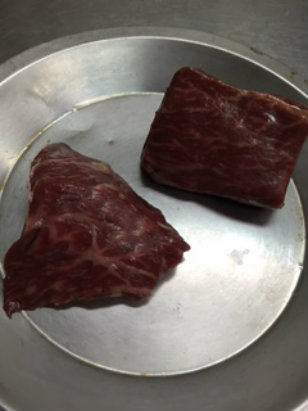
2. Cook both sides of the ichibo evenly. We recommend cooking on high heat for 30seconds x 5sets. Remove from heat, then rest beef in aluminum foil after each set.
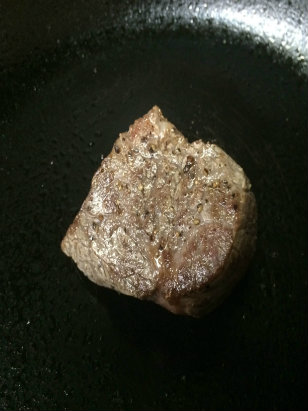
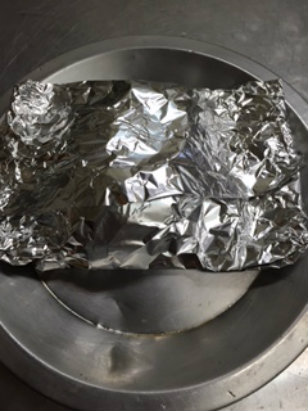
3. Bring the internal temperature of the beef to 55℃, let the beef rest for 2-3 minutes. Serve.
Tips and advice
By cooking this way, the meat at the center will stay rare. Letting the meat rest will make the meat more juicy. -
Corn tempura
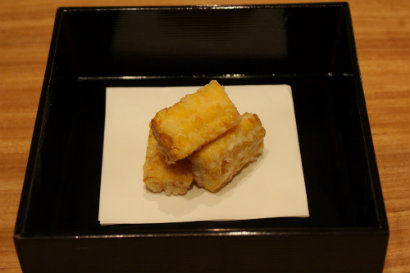 Corn 1/2 a cob of corn1. Wrap corn in plastic wrap and steam in steamer for about 20 minutes.
Corn 1/2 a cob of corn1. Wrap corn in plastic wrap and steam in steamer for about 20 minutes.
2. Cut corn and fry tempura style(See Shiratsugu Basics) -
Eggplant with miso paste garnish
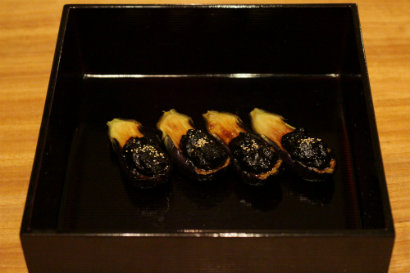 Small Eggplant 2
Small Eggplant 2
Eggplant Miso Paste Optimal amount (See Zucchinni with miso paste garnish) (See Zucchinni with miso paste garnish)
Poppy Seed Optimal amount1. Cut off the stem end of the eggplant, then cut in half lengthwise.
2. Deep fry without bread and batter, paste with miso, bake in oven for 5 minutes at 180℃.
3. Sprinkle with poppy seeds. Serve -
Simmered renkon (Lotus root)
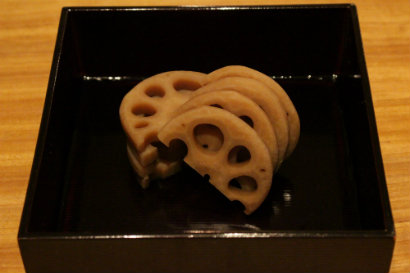 Renkon Lotus root
Renkon Lotus root
Vinegar 1 Teaspoon
A
Dashi 500cc(please see Shiratsugu Basics)
Sugar 2 Tablespoons
Soy sauce 2 Tablespoons1. Cut Renkon into 1cm round slices, skin the renkon and chamfer (trim the edges so the right angles are rounded).
2. Add 1 teaspoon of vinegar to pot of water and simmer renkon for about ten minutes, until you can easily poke a large toothpick or skewer through renkon. Strain.
3. Put simmered renkon from step 2 into (A) and simmer for about 10 minutes. Cut in half and serve. -
Aji tamago (seasoned soft boiled egg)
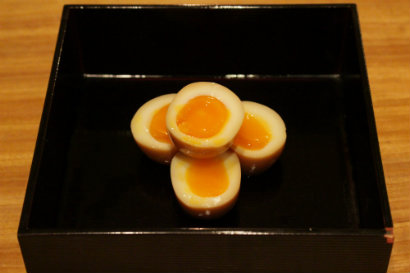 1. Make soft boiled eggs. Boil eggs in a pot from cold water. After the water comes to a boil, begin timing eggs to boil for 5 minutes. Stop heat and put eggs into ice water. Remove shells under running water.
1. Make soft boiled eggs. Boil eggs in a pot from cold water. After the water comes to a boil, begin timing eggs to boil for 5 minutes. Stop heat and put eggs into ice water. Remove shells under running water.
2. Put eggs into zip lock bag and add (A) and marinate for 12 hours.
3. Cut in half horizontally. Serve. -
Kuri no kanroni (candied chestnuts)
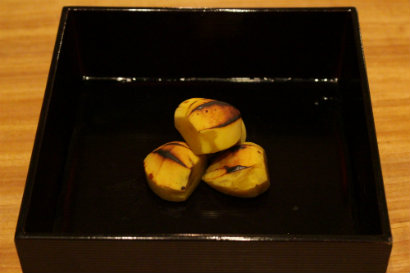 Japanese chestnuts 4
Japanese chestnuts 4
Chestnuts Kuchinashi (gardenia fruit) 2 Kuchinashi
(A)
Granulated sugar 300g
Water 900cc1. Hull chestnuts, soak in water. 2. Wrap the kuchinashi fruit in cloth, crush the fruit and steep in 1 liter of water. When you can see that you have extracted the color, remove kuchinashi from pot. (Wrap kuchinashi in sarashi
(cheesecloth)
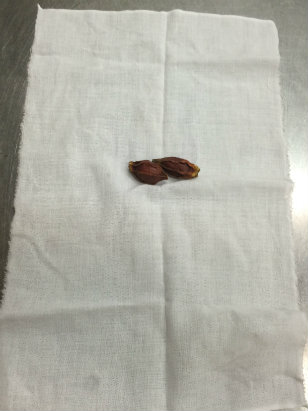
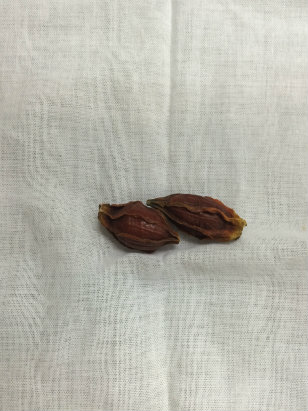
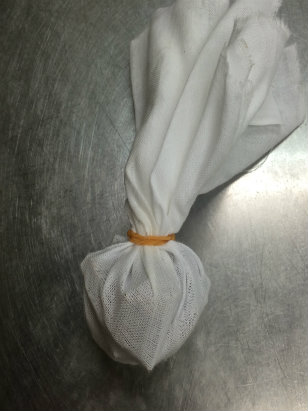
(Crush kushinashi fruit after wrapping in cloth)
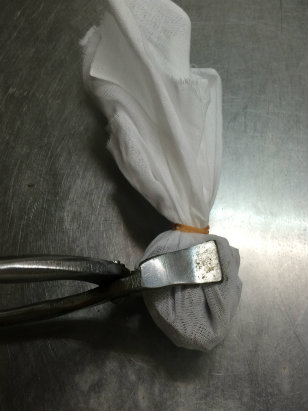
(Steep)
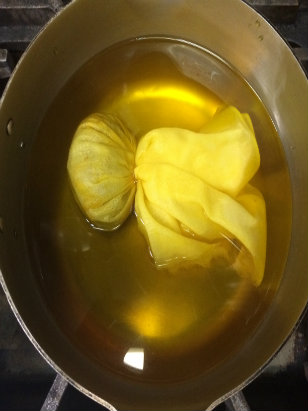
3. Use the kuchinashi brew to carefully cook the chestnuts. Take care not to let the water boil as you cook until the chestnuts become soft (approximately 3 hours).
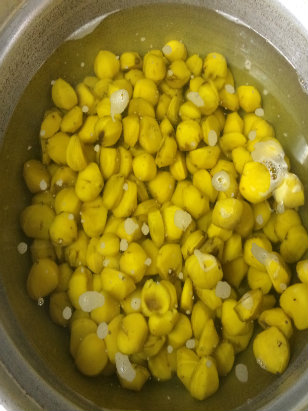
4. Once the chestnuts are cooked, put in cold water. Strain. 5. Put chestnuts in (A) and cook for 30 minutes at a temperature that makes the chestnuts slowly bubble. 6. Remove from (A) and use a burner to char chestnuts. Serve.
Cooking tips
Use of the Kuchinashi gardenia fruit is optional. We use it to give the chestnuts a brilliant yellow color. Use it to your liking. -
Inari sushi
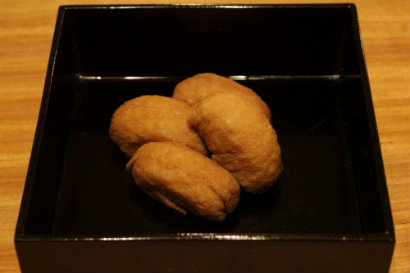 Usuage (Thin deep-fried tofu) 2 pieces
Usuage (Thin deep-fried tofu) 2 pieces
Sushi rice Enough for 4 pieces (See Shiratsugu basics)
(A)
Dashi 500cc (please see Shiratsugu Basics)
Soy sauce 3 Tablespoons
Sugar 4 Tablespoons
Mirin 4 Tablespoons1. Immerse Usuage in boiling water and strain to remove excess oil.
2. Heat (A) and use it to cook Usage on medium heat for 10 minutes.
3. Shape sushi rice into cylindrical size that will fit into the Usuage tofu.
4. Cut Usuage from the center, make a rectangular shape, fill with sushi rice and shape carefully. Serve.
Cooking tip
Four inari sushi are made of about 0.5 cups of rice. -
Tri-colored ohagi rice cakes
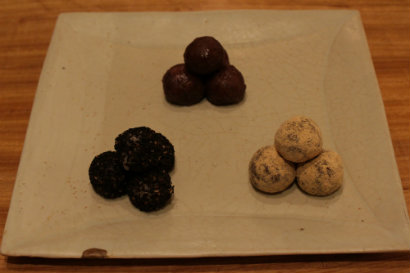 Tsubuan (mashed red bean paste) 100g
Tsubuan (mashed red bean paste) 100g
Mochi rice 100g
Kinako (roasted soybean flour) Optimal amount
Black sesame Desired amount1. Cover cooked mochi rice with tsubuan to make ohagi. To make kinako ohagi and black sesame ohagi, coat with ingredients accordingly.
(How to cook Mochi Rice)
1.Steep rice in water for half a day (more than 8 hours).
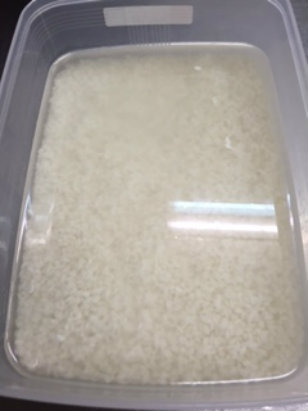
2. Strain rice and spread out on sarashi (cheesecloth). Cook in steamer for 50 minutes on medium heat.
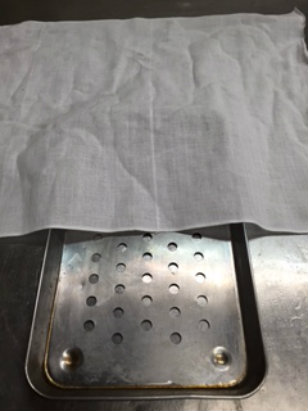
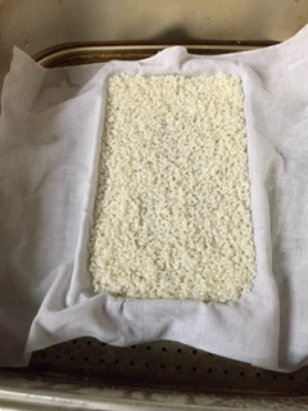
3. Put cooked rice into a bowl and add hot water until rice is almost submerged. Cover with plastic wrap and wait 5 minutes. Next, cook rice in steamer of an additional 10 minutes.
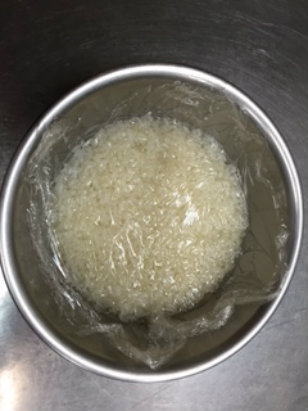
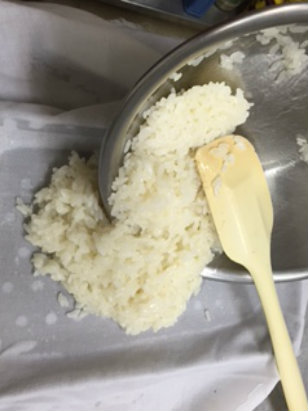
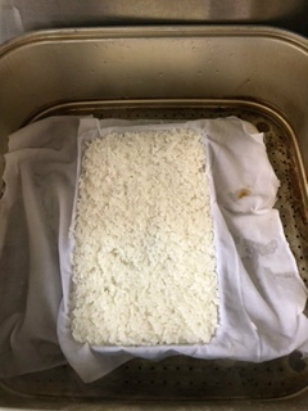
4. Use the edges of the sarashi cheesecloth to mash the rice. (don’t completely mash. Mash about 70percent of the rice).
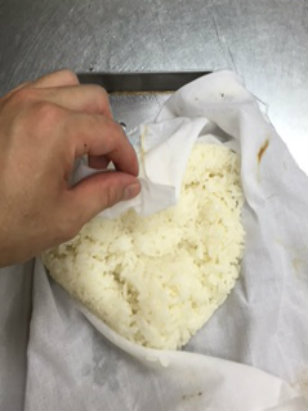
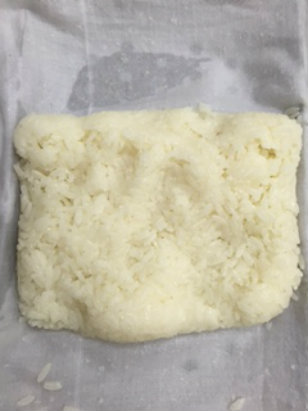
Cooking tips
If you don’t have a cooking sheet that has a few holes in it, it is best if you only use the sarashi (a cooking sheet without holes will not be able to strain the weather from the rice, making it soggy and gooey) As for the hot water used to cover the rice in (step 3), it will not make the rice soggy as the rice will take it in after five minutes. -
Preview of next Ichijyusansai
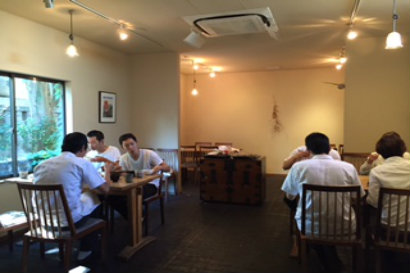 Next up is the Kanro no Zen
Next up is the Kanro no Zen
The next menu will be using even more seasonal foods. And the results are just as awesome as autumn!
Pictures- On a sunny day in autumn, everybody is enjoying the Shiratsugu staff meal. The master chef made Nameko soba noodles.
